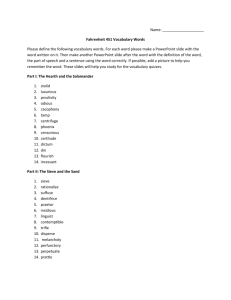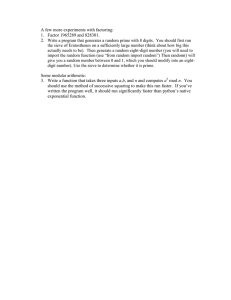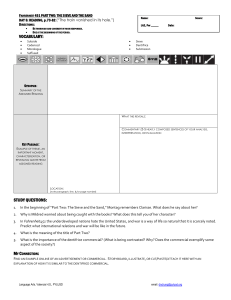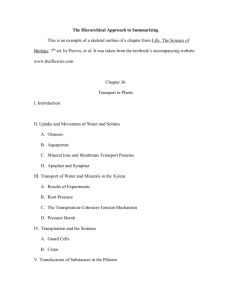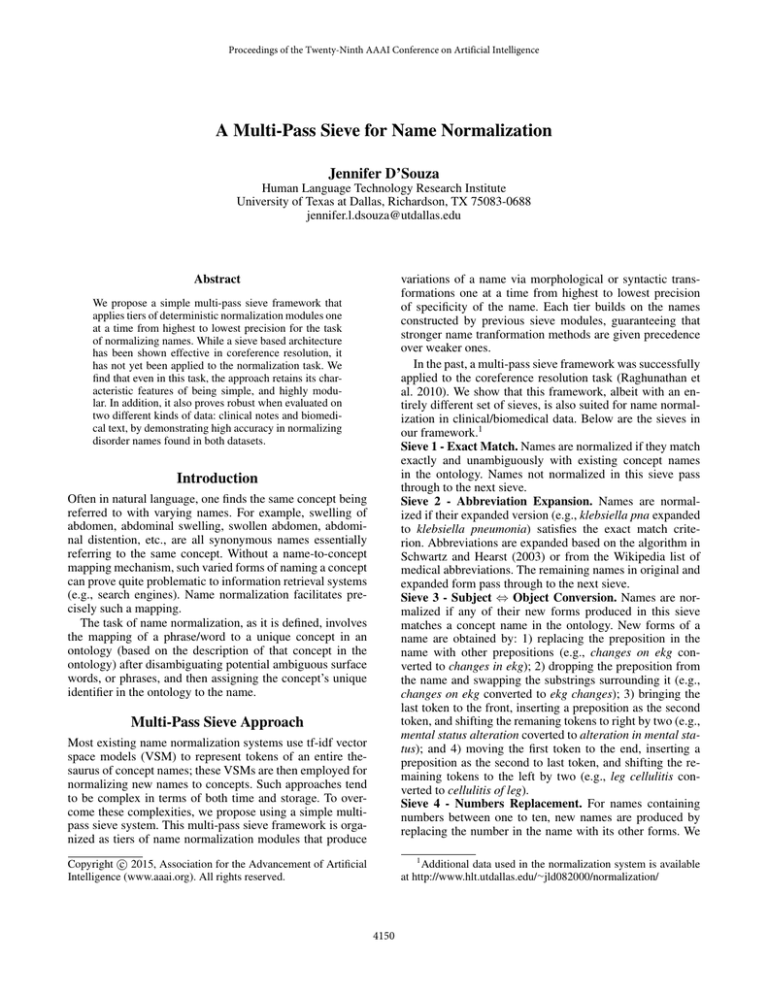
Proceedings of the Twenty-Ninth AAAI Conference on Artificial Intelligence
A Multi-Pass Sieve for Name Normalization
Jennifer D’Souza
Human Language Technology Research Institute
University of Texas at Dallas, Richardson, TX 75083-0688
jennifer.l.dsouza@utdallas.edu
Abstract
variations of a name via morphological or syntactic transformations one at a time from highest to lowest precision
of specificity of the name. Each tier builds on the names
constructed by previous sieve modules, guaranteeing that
stronger name tranformation methods are given precedence
over weaker ones.
In the past, a multi-pass sieve framework was successfully
applied to the coreference resolution task (Raghunathan et
al. 2010). We show that this framework, albeit with an entirely different set of sieves, is also suited for name normalization in clinical/biomedical data. Below are the sieves in
our framework.1
Sieve 1 - Exact Match. Names are normalized if they match
exactly and unambiguously with existing concept names
in the ontology. Names not normalized in this sieve pass
through to the next sieve.
Sieve 2 - Abbreviation Expansion. Names are normalized if their expanded version (e.g., klebsiella pna expanded
to klebsiella pneumonia) satisfies the exact match criterion. Abbreviations are expanded based on the algorithm in
Schwartz and Hearst (2003) or from the Wikipedia list of
medical abbreviations. The remaining names in original and
expanded form pass through to the next sieve.
Sieve 3 - Subject ⇔ Object Conversion. Names are normalized if any of their new forms produced in this sieve
matches a concept name in the ontology. New forms of a
name are obtained by: 1) replacing the preposition in the
name with other prepositions (e.g., changes on ekg converted to changes in ekg); 2) dropping the preposition from
the name and swapping the substrings surrounding it (e.g.,
changes on ekg converted to ekg changes); 3) bringing the
last token to the front, inserting a preposition as the second
token, and shifting the remaning tokens to right by two (e.g.,
mental status alteration coverted to alteration in mental status); and 4) moving the first token to the end, inserting a
preposition as the second to last token, and shifting the remaining tokens to the left by two (e.g., leg cellulitis converted to cellulitis of leg).
Sieve 4 - Numbers Replacement. For names containing
numbers between one to ten, new names are produced by
replacing the number in the name with its other forms. We
We propose a simple multi-pass sieve framework that
applies tiers of deterministic normalization modules one
at a time from highest to lowest precision for the task
of normalizing names. While a sieve based architecture
has been shown effective in coreference resolution, it
has not yet been applied to the normalization task. We
find that even in this task, the approach retains its characteristic features of being simple, and highly modular. In addition, it also proves robust when evaluated on
two different kinds of data: clinical notes and biomedical text, by demonstrating high accuracy in normalizing
disorder names found in both datasets.
Introduction
Often in natural language, one finds the same concept being
referred to with varying names. For example, swelling of
abdomen, abdominal swelling, swollen abdomen, abdominal distention, etc., are all synonymous names essentially
referring to the same concept. Without a name-to-concept
mapping mechanism, such varied forms of naming a concept
can prove quite problematic to information retrieval systems
(e.g., search engines). Name normalization facilitates precisely such a mapping.
The task of name normalization, as it is defined, involves
the mapping of a phrase/word to a unique concept in an
ontology (based on the description of that concept in the
ontology) after disambiguating potential ambiguous surface
words, or phrases, and then assigning the concept’s unique
identifier in the ontology to the name.
Multi-Pass Sieve Approach
Most existing name normalization systems use tf-idf vector
space models (VSM) to represent tokens of an entire thesaurus of concept names; these VSMs are then employed for
normalizing new names to concepts. Such approaches tend
to be complex in terms of both time and storage. To overcome these complexities, we propose using a simple multipass sieve system. This multi-pass sieve framework is organized as tiers of name normalization modules that produce
1
Additional data used in the normalization system is available
at http://www.hlt.utdallas.edu/∼jld082000/normalization/
c 2015, Association for the Advancement of Artificial
Copyright Intelligence (www.aaai.org). All rights reserved.
4150
AccShARecorpus AccN CBIcorpus
Sieve 1
83.2
69.4
+ Sieve 2
84.5
74.5
+ Sieve 3
84.7
74.6
+ Sieve 4
84.8
75.5
+ Sieve 5
85.2
76.5
+ Sieve 6
85.9
77.1
+ Sieve 7
87.7
78.8
+ Sieve 8
88.3
83.3
Table 1: Normalization accuracies on test data from the ShARe
consider the numeral, roman numeral, cardinal, and multiplicative forms of a number for mapping and replacement.
For example, three vessel disease becomes the set {3 vessel
disease, iii vessel disease, and triple vessel disease}. Normalization is by exact match with a concept name.
Sieve 5 - Disorder Synonyms Replacement. For names
containing a disorder term, new names are created by replacement of the disorder term with its synonyms.2 For example, presyncopal events becomes {presyncopal disorders,
presyncopal episodes, etc.}. And for names that do not contain a disorder term, new names are created by appending
the given name with a disorder synonym. E.g., crohns becomes {crohns disease, crohns disorder, etc.}. Normalization of these new names is by exact match with a concept
name in the ontology.
Sieve 6 - Affixation. Names satisfying affixation patterns
observed in training data are affixated in this sieve. For example, infectious source became source of infectious in sieve
3, which then becomes source of infection in this sieve. As
in earlier sieves, normalization of affixated forms of names
is by exact match with a concept name.
Sieve 7 - Stemming. Names are stemmed using the Porter
stemmer, and then checked for normalization by exact match
with stemmed concept names.
Sieve 8 - Partial Match. Unlike earlier sieves, where new
names were created for names produced from all preceding
sieves, this sieve module uses only the output from sieve 2
i.e. either the abbreviation expanded form of the name, if
available, or the given name itself. In clinical notes, the following criteria were used for normalization by partial match:
if the given name tokens matched exactly, irrespective of order, with tokens of a concept name; or for names containing two or more tokens, if a concept name in the ontology
matched unambiguously with its tail substring. In biomedical text, names were normalized to the concept with which
it shared the most name tokens. And in the case of ties, the
concept with the shortest name length was preferred.
Note that, as not all names are included as concepts in
the ontology, a subset of the annotated disorder names do
not have concept identifiers. Therefore, the default setting of
our framework was to normalize names as “CUI-less”.
corpus and the NCBI corpus, respectively, as sieves are added to
the multi-pass sieve system.
Results and Conclusion
We present the results of our approach in Table 1. Performance is reported as the percentage accuracy in normalizing names. Our sieve model outperforms the best performance (Leaman, Doğan, and Lu 2013) reported at 82.2
on the NCBI corpus, and ranks close to the best performance (Ghiasvand and Kate 2014) reported at 89.5 on the
ShARe corpus. Thus we have shown that in spite of its simplicity, a multi-pass sieve approach is suitable to the normalization task. In addition, its modular architecture is highly
advantageous to facilitating further improvement without
any major changes to the existing modules.
Acknowledgements
With thanks to the two reviewers for helpful feedback on an
earlier version of this article.
References
Campbell, K. E.; Oliver, D. E.; and Shortliffe, E. H. 1998. The unified medical language system: Towards a collaborative approach
for solving terminologic problems. J Am Med Inform Assoc
5(1):12–16.
Davis, A. P.; Wiegers, T. C.; Rosenstein, M. C.; and Mattingly, C. J.
2012. Medic: a practical disease vocabulary used at the comparative toxicogenomics database. Database 2012:bar065.
Doğan, R. I.; Leaman, R.; and Lu, Z. 2014. Ncbi disease corpus: A
resource for disease name recognition and concept normalization.
J Biomed inform 47:1–10.
Ghiasvand, O., and Kate, R. 2014. Uwm: Disorder mention extraction from clinical text using crfs and normalization using learned
edit distance patterns. In Proceedings of SemEval 2014, 828–832.
Leaman, R.; Doğan, R. I.; and Lu, Z. 2013. Dnorm: disease
name normalization with pairwise learning to rank. Bioinformatics
2909–2917.
Porter, M. F. 1980. An algorithm for suffix stripping. Program
14(3):130–137.
Pradhan, S.; Elhadad, N.; South, B.; Martinez, D.; Christensen, L.;
Vogel, A.; Suominen, H.; Chapman, W.; and Savova, G. 2013. Task
1: Share/clef ehealth evaluation lab 2013. Online Working Notes of
CLEF, CLEF 230.
Raghunathan, K.; Lee, H.; Rangarajan, S.; Chambers, N.; Surdeanu, M.; Jurafsky, D.; and Manning, C. 2010. A multi-pass
sieve for coreference resolution. In Proc. of the 2010 Conference
on EMNLP, 492–501.
Schwartz, A., and Hearst, M. 2003. A simple algorithm for identifying abbreviation definitions in biomedical text. In Proc. of the
8th PSB, 451–462.
Corpora
We used the following corpora in our experiments:
Clinical Notes - The ShARe/CLEF eHealth Challenge (Pradhan et al. 2013) corpus contained 199 notes for
training and 99 notes for testing. Concept identifiers from
training data and from the UMLS Metathesaurus (Campbell, Oliver, and Shortliffe 1998) were used for normalizing
names from this corpus.
Biomedical Abstracts - The NCBI disease corpus (Doğan,
Leaman, and Lu 2014) contained 693 abstracts for training and development, and 100 abstracts for testing. Concept
identifiers from training data and from the MEDIC (Davis et
al. 2012) lexicon were used for names from this corpus.
2
A list of synonyms of the disorder concept are obtained from
training data.
4151

